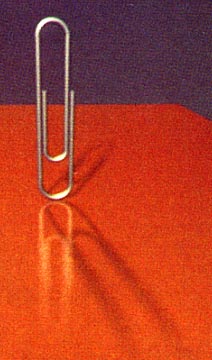|
|
Other Effects
The T-Buffer can also be used for soft shadows and reflectance blur. Take a look at your shadow on the floor - you'll notice that it doesn't have abrupt, clearly defined edges like those generated by computers. Even the fabled volumetric shadows produced by Unreal in conjunction with a Stencil Buffer have these hard edges. A similar situation exists with reflections off surfaces that are not 100% reflective, such as stainless steal or semi-glossy surfaces. The T-buffer solves these problems yet again through supersampling.
Support Issues
As mentioned above, spatial anti-aliasing can simply be turned on in the driver and will automatically be supported by every game ever written, regardless of API. Unfortunately, motion blur, depth of field, and any other T-Buffer techniques will require specific coding by game designers as well as API support. Support in OpenGL and Glide are essentially guaranteed - OpenGL has support for extensions and 3dfx controls Glide completely. 3dfx is currently making efforts towards having T-Buffer support in DirectX 7, but Microsoft has generally shied away from vendor specific extensions to their API. And make no doubt, 3dfx is not planning to share the T-Buffer technology with the rest of the world - it's definitely a proprietary 3dfx technique.
As such, 3dfx was forced to write their own demo to show off the motion blur effects and depth of field effects. By far the easiest way to see this in action is to download the 4.7MB MPEG video of the demo. It's a split screen demo with standard rendering on the left and all T-Buffer effects enabled on the right. You'll notice the anti-aliasing effects immediately on the sign that appears at the start of the video. Next, the racers rev their engines as a cop watches from behind the sign. As the racers cars bob up and down, a subtle motion blur effect is applied to the cars. Then, you'll see depth of field in action as first the camera focuses on the cop, and then switches to the racers. Motion blur can be seen again as the cars take off with the cop chasing after them.
Note that this demo was written by 3dfx in a very short time simply to show the T-Buffer in action. You'll notice that at times, especially with fast moving objects, that the motion blur looks more like a set of distinct images blended together, rather than the intended single blurred object. Well, that's exactly what they are, but 3dfx claims that if written carefully, the effect is much more impressive. Further, this demo was shown using a Voodoo2 based Quantum 3D emulation box and was thus limited to 16-bit rendering. An actual product with T-Buffer support will have true 32-bit external rendering available to it and would actually look even better.











0 Comments
View All Comments